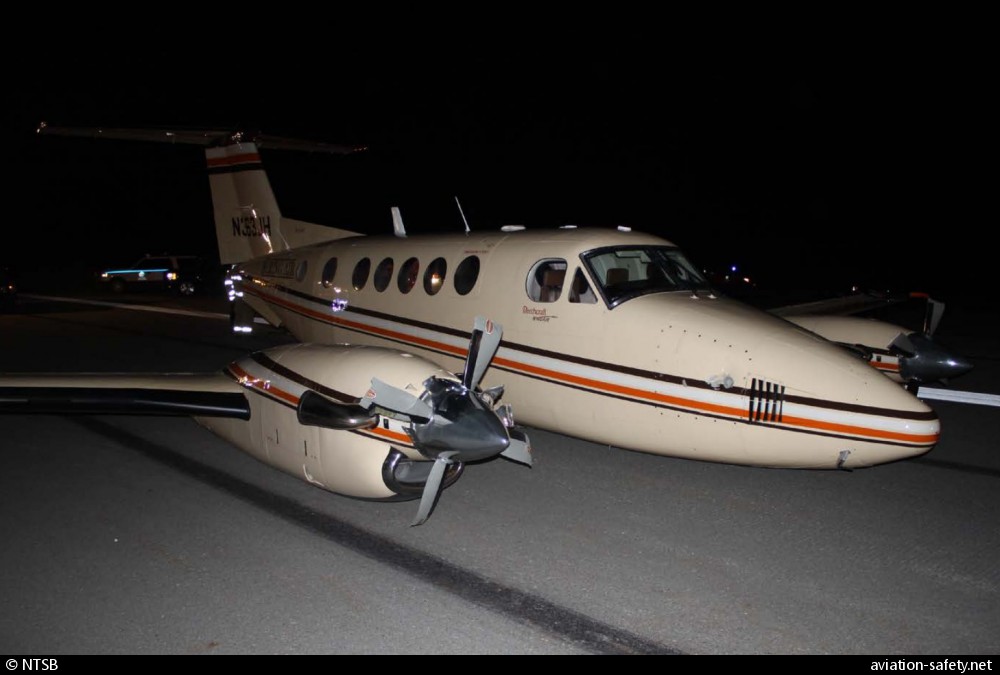
| Date: | Saturday 21 October 2017 |
| Time: | 05:36 |
| Type: |  Beechcraft B200 King Air |
| Owner/operator: | Bering Air |
| Registration: | N363JH |
| MSN: | BB-1799 |
| Year of manufacture: | 2002 |
| Total airframe hrs: | 3182 hours |
| Engine model: | Pratt & Whitney Canada PT6A-41 |
| Fatalities: | Fatalities: 0 / Occupants: 4 |
| Aircraft damage: | Substantial, repaired |
| Category: | Accident |
| Location: | Anchorage-Ted Stevens International Airport, AK (ANC) -
 United States of America United States of America
|
| Phase: | Landing |
| Nature: | Ambulance |
| Departure airport: | Nome Airport, AK (OME/PAOM) |
| Anchorage-Ted Stevens International Airport, AK (ANC/PANC) | |
| Investigating agency: | NTSB |
| Confidence Rating: |
A Beech B200 airplane, N363JH, sustained substantial damage following an unintentional gear-up landing at the Anchorage-Ted Stevens International Airport, Alaska. The airplane departed from the Nome Airport, Alaska, about 03:20 .
The purpose of the flight was to transport a patient to a medical treatment facility in Anchorage. As the flight descended through about 4,000 feet msl, towards Anchorage, the captain visually confirmed that the airport was in sight, and requested a visual approach. He reported the air traffic controller didn't respond to his initial request, and he requested a visual approach again. The controller responded back with a vector for the instrument landing system (ILS) runway 7R approach. The pilot reported his groundspeed was about 210 knots indicated, he joined the final approach course, and was cleared to land. He reported he believes he was given a vector heading that was too close to the final approach fix and the airplane went through the final approach fix. The pilot then received another heading and he re-established himself on the final approach course.
According to the pilot, as the airplane continued on the ILS 7R approach, he began to configure the airplane for landing by selecting the appropriate approach wing flaps setting, and he believed he selected the landing gear selector to the down position. However, he failed to confirm that the landing gear position-indicator lights showed "three green" indicting the landing gear was down, locked, and safe for landing. The pilot said that during touchdown with the landing gear not extended, the airplane's belly-mounted cargo pod contacted the runway, and the airplane began to veer to the right of the runway centerline. The 4 blade Hartzell propeller assemblies for each engine separated about midspan due to runway impact damage. The left side forward fuselage sustained minor damage from various separated propeller blade debris impacts. The airplane came to rest on the right side of the runway, and the occupants egressed without further incident.
During a postaccident on scene inspection of the accident airplane, the landing gear selector was found in the down position.
Probable cause:"The pilot's failure to extend the landing gear before landing, which resulted in a gear-up landing. Contributing to the accident was the pilot's fatigue and complacency."
Accident investigation:
 |
|
Sources:
Location
Images:

photo (c) NTSB; Anchorage-Ted Stevens International Airport, AK (ANC); 21 October 2017; (publicdomain)
Revision history:
| Date/time | Contributor | Updates |
|---|
The Aviation Safety Network is an exclusive service provided by:


 ©2024 Flight Safety Foundation
©2024 Flight Safety Foundation